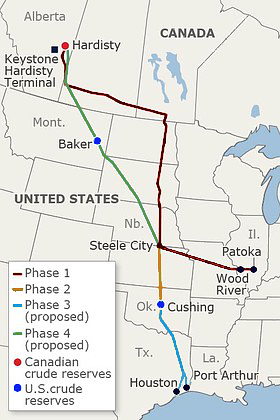 Most everyone has heard about the proposed Keystone XL pipeline at this point. The international pipeline is proposed to deliver Canadian crude oil from northeastern Alberta to markets and refineries in the United States. The pipeline is already partially constructed but must be approved by the State Department before it can cross the US/Canada border. President Obama rejected the first application in 2012, citing concerns about the impact of the pipeline passing through the Sand Hills region of Nebraska. All of this found me asking, “What’s the big deal? There is a latticework of pipelines that crisscross the country. Why is everyone up in arms about this one?” Which led me to the much more important question: “Are pipeline leaks common enough to be such a big issue?” I was surprised to find the answer to this is a loud and resounding YES.
Most everyone has heard about the proposed Keystone XL pipeline at this point. The international pipeline is proposed to deliver Canadian crude oil from northeastern Alberta to markets and refineries in the United States. The pipeline is already partially constructed but must be approved by the State Department before it can cross the US/Canada border. President Obama rejected the first application in 2012, citing concerns about the impact of the pipeline passing through the Sand Hills region of Nebraska. All of this found me asking, “What’s the big deal? There is a latticework of pipelines that crisscross the country. Why is everyone up in arms about this one?” Which led me to the much more important question: “Are pipeline leaks common enough to be such a big issue?” I was surprised to find the answer to this is a loud and resounding YES.
Frequency of pipeline leaks
Between the years 2000 and 2012, there were more than 200 pipeline leaks in the United States alone. Many of these were quickly discovered and had little impact on the environment. However some of these incidents resulted in very large releases at a cost of millions to remediate. On January 27, 2000 a dent in the bottom of a pipeline in Westchester, Kentucky ruptured and released 490,000 gallons of crude oil. This incident alone cost 7.1 million dollars to clean up. A 2001 rupture of the Dome Pipeline in North Dakota burned 1.1 million gallons of gasoline before it was shut down. In 2011, TransCanada, the company building the XL pipeline, experienced a 20,000-gallon spill from a portion of the already completed Keystone pipeline in North Dakota.
What is the alternative?
Statistics like these can and should give anyone pause while considering the approval of the Keystone XL pipeline, however, it is important to measure the risk against the alternatives. The simple fact is that without the pipeline, Canada will still harvest the Athabasca oil sands, and the product will still be delivered to the US market. With no pipeline to send it through, this oil will likely be piped to the western coast of Canada and brought south by tanker ship through the Gulf of Alaska. This will increase already heavy marine traffic in the gulf. In addition, spills at sea are much more difficult to effectively remediate and can have a critical impact on sensitive aquatic ecosystems. Spills on land, while regrettable, can typically be both accessed and cleaned up faster with less environmental impact than a spill at sea.
Spills are going to happen. The transportation of oil and gas products is a human-operated system and any such system will inevitably exhibit flaws. The image of oil barons twisting their mustaches and laughing as money rolls in and cities burn is easy to picture but far from the truth. It’s actually much more aligned with their business interests to see that every drop of oil or gas gets to market. In addition to loss of valuable inventory, spills also result in remediation expenses and public relations nightmares that can take a big piece out of a company. In the wake of the Deepwater Horizon blowout, BP’s stock price fell from $648 to $319 in two months. As of today, the company’s share price has only managed to creep back up to $447 in nearly three years. It is important to remember that oil companies have a significant financial interest in preventing these incidents whenever possible.
A balanced approach
I, for one, support construction of the Keystone XL pipeline as well as President Obama’s decision to delay the pipeline until potential environmental impact issues are addressed. In the long run it will be in TransCanada’s best interest to ensure that the pipeline passes through as few sensitive areas as possible, minimizing impact in the event of a leak. In the longer term, we need to decide how best to transport these materials. There’s a “not in my backyard” mentality that is overtaking the debate. Yet if we continue to move these minerals via navigable waters, we risk harming the delicate ecosystems of species that are in no way benefiting from the product.
Please leave your comments below.
 Justin Ripple
Justin Ripple
Document Research Services
banks@banksinfo.com

Great Article!
Thanks Christy, I appreciate the feedback.
The cost to clean up spills should not be a factor in deciding whether to allow construction of a pipeline. Pipeline owners are responsible and bear the cost. Cleanup cost is not necessarily an indicator of long term environmental damage. Cleanup technology has made great advances. I think that ecosystems recover more quickly than pipeline opponents care to acknowledge.